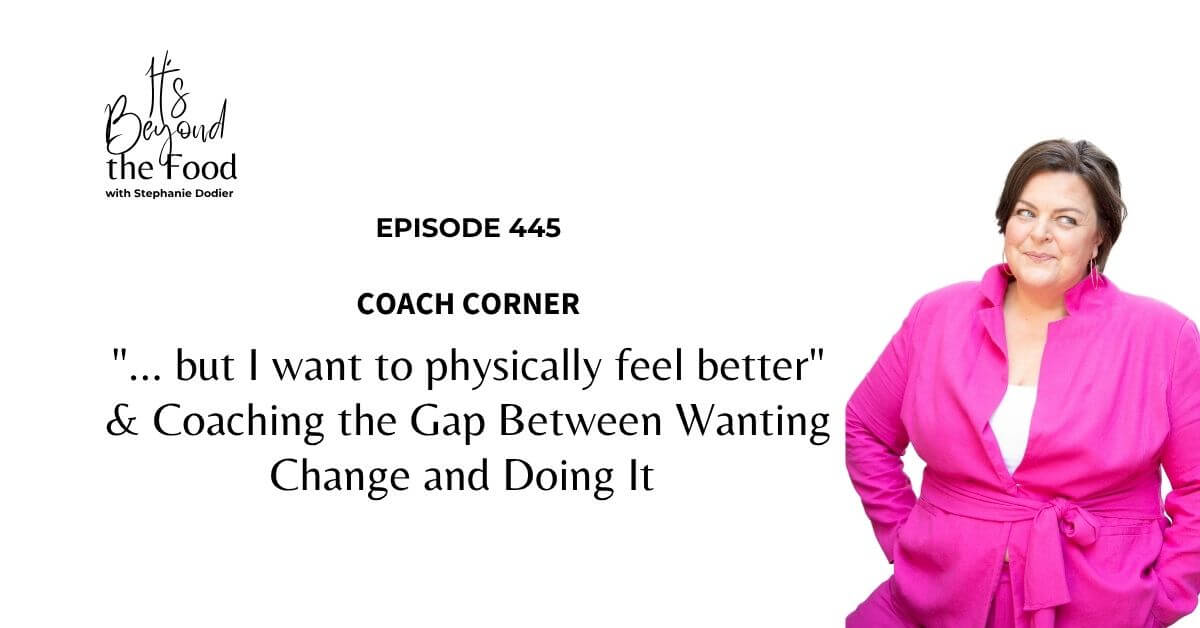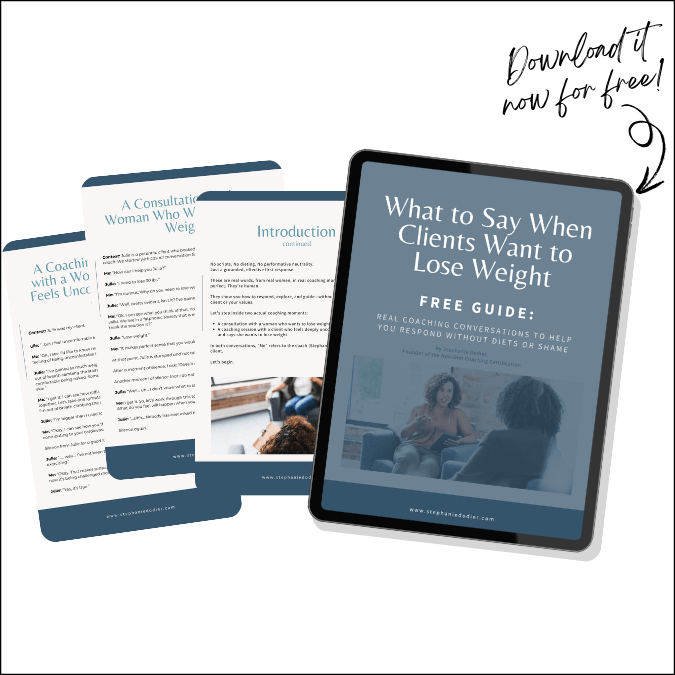

In this Coach Corner episode, I’m tackling one of the most common things I hear from clients: “But I want to physically feel better.” Maybe you’ve heard your clients say the same thing—and maybe, like you, they’re struggling to separate physical well-being from the desire for weight loss. This episode breaks down how we, as coaches, can skillfully and compassionately guide clients through that mental tangle.
You’ll hear how to coach in real conversations—not over email or DMs—so your clients can start seeing that feeling better doesn’t require shrinking their bodies. I walk you through examples, mindset shifts, and exactly when to shift between mentoring and coaching. If your clients know diets don’t work but still feel stuck, this is the episode you’ve been waiting for.
Episode Highlights & Timeline
[1:00] – The exact client words that inspired this episode
[2:14] – Why separating “feeling better” from “getting smaller” is essential
[2:51] – How confirmation bias traps your client in weight-focused thinking
[3:17] – The glasses metaphor I use to explain cognitive bias
[5:08] – Using weight-neutral examples to disrupt old beliefs
[6:00] – When to shift from coach to mentor and why it matters
[7:05] – How to help clients explore real solutions for physical discomfort
[8:00] – Coaching the gap between “wanting to change” and “actually changing”
[9:00] – What illusion thinking sounds like and how to spot it
[10:00] – Why unconscious thoughts can stop your clients cold
[11:23] – How to use Socratic questioning to get to the root beliefs
[12:41] – How to guide your client toward quality, aligned decisions
Mentioned in the show:
Non-Diet Coaching Certification Waitlist
What To Say When Clients Want To Lose Weight Guide
Full Episode Transcript
This transcript was auto-generated and lightly edited for clarity.
Click to expand the full transcript
How can health coaches help clients improve physical well-being without weight-loss goals?
Health coaches can support physical well-being without focusing on weight loss by helping clients:
Build strength and stamina through joyful, accessible movement
Improve mobility and reduce pain with targeted physical therapy or stretching
Support better sleep, energy, and mood through lifestyle changes
Focus on sustainable habits like hydration, stress management, and balanced eating
Reframe health goals around how clients feel, not how they look
This approach respects body diversity and centers long-term well-being over short-term fixes.
[00:00:00] Stephanie: Welcome to It’s Beyond the Food Podcast, my sisters. I’m your host, Stephanie Dosier in today we’re back with another episode of our miniseries called Coach Corner, and this series is for all the health professional who want to learn how to coach behavior and mindset without reinforcing diet culture.
[00:00:20] Stephanie: Now, before we dive in, if you love these short focused episode, go grab the free coach corner vault. It’s my on-demand library of over 50 mini training on mindset, body image, eating behavior, and even a little bit of business coaching. You can go and grab it at stephaniedodier.com/coach-corner, or check out your podcast app in the show notes section, there should be a link in there.
[00:00:51] Stephanie: Let’s dive in. The first question that you guys submitted is this one. How do I help my [00:01:00] client when they say quote, but I want to physically feel better. Now, this is a very common one, and I wanna use a very specific example for answering this question because it’s gonna help me.
[00:01:17] Stephanie: Teach you how to coach that. And the person who submitted this question is a dietician and she gave me the exact word that a client submitted on an intake form. So it reads like this in client words. I feel so terribly physically, I’m out of breath. When I climb the stairs to my apartment. My hips hurt when I stand up from a chair.
[00:01:44] Stephanie: I’m a mess. The only solution I can see is losing weight. But I know this doesn’t work. I’m lost. So the first place we want to start with our client is number one. This cannot be coached [00:02:00] through DM or through email. This needs to be a physical conversation, one-on-one, you in front of the client because there’s gonna be a lots of back and forth in this coaching situation.
[00:02:14] Stephanie: Our goal is to separate, wanting to feel better physically and wanting to be smaller. Because as we know, these two desires are not the same. And what’s holding back your client is something called confirmation bias. Confirmation bias is the tendency that our brain has to search. For an interpret evidence situation, facts, things that we observe so that its support our current belief and value.
[00:02:51] Stephanie: One great example of that. Outside of our field is like political belief or even gender [00:03:00] assumption, like women are weaker. When someone believes that women are weaker and men are stronger, they are going to scan their environment to look for evidence and proof that this is true. When I teach that to our client confirmation bias I like to.
[00:03:17] Stephanie: Think about glasses. If you’re watching me on YouTube right now, you’re seeing that I’m playing with my glasses because confirmation bias is like a pair of glasses you put on every morning to prove that your own belief system is true and quote, the right one. So in the case of our niche, most people believe that weight loss equals health.
[00:03:44] Stephanie: Because they’ve been socialized to that. So it makes total sense that their brain goes through their current life and shows them why it is true that they need to lose weight, that their hip pain, that their cardiovascular [00:04:00] capacity is going to get better. As a result of weight loss and that they’re looking for evidence of that, that it is true or not, and this client says it perfectly.
[00:04:11] Stephanie: I know it doesn’t work. I don’t know the details of that client, but I’ve been through that with thousands of people, like they’ve been dieting for 10 or 15 years. They know it doesn’t work yet. They still want it. And their brain will continue to do this until they work with you and actually change their thoughts and their belief system.
[00:04:35] Stephanie: ’cause the brain will not stop the cognitive bias of confirmation bias. They will not stop that. It will constantly do that because that’s how our brain is wired to evolve and stay safe. What we need to do is change the belief and the thought that the brain is scanning for evidence. So instead of looking for evidence that weight loss is the answer [00:05:00] we need to help your client put new thoughts and beliefs so it scans for weight neutral answer.
[00:05:08] Stephanie: So a great way to do that is using example. So I want to take two people that I know of that I follow on social media. One is Meg Boggs. She’s a woman who’s a larger body who is a weightlifter and she is weightlifting heavyweight. She’s super strong. Yet, she’s in the larger body, and I will often bring my client to go and visit her profile, or Mina Valerio, who is an ultra marathon runner, and she has shared her weight before at 250 pounds.
[00:05:49] Stephanie: And I will bring my client to see that. To see these evidence that it is possible to put new information in the brain of our [00:06:00] client. Now, this is where we have to teeter totter between teeter-totter. That’s a new word for me. We have to go over the edge of mentoring and coaching. One of my student in a non diet coaching certification was telling me this, she’s a certified coach in the executive coaching world, and she was telling me how she’s seeing that our niche, our environment of coaching requires us to be mentor in sometimes. So Norma, if you’re listening to this, I’m quoting you here, but this is part of our work to help our clients separate, wanting to feel better, and wanting to lose weight. We need to bring these evidence forward, so we need to go in a mentor mode, helping our clients see that they can work on their cardiovascular capacity, that losing weight is not gonna improve their cardiovascular capacity. They will still be out of breath climbing the stairs. What they need to do is actually go through a protocol, perhaps with a [00:07:00] fitness trainer to improve their cardiovascular capacity, and that can be done at any body size.
[00:07:05] Stephanie: Same thing with the hips hurting. We need to show our client that there is a solution that actually the lack of mobility, the lack of flexibility will not be solved by weight loss. It probably will have their hips pain even if they lose weight. So what can we do? We need to work with a mobility instructor.
[00:07:26] Stephanie: We need to work with a physical therapist to give them a protocol to work on their hips. At any weight. So we need to teeter-totter between being a mentor and a coach on that and separating, wanting to feel better, showing them that there’s a tool to do that and wanting to be smaller. Once we separated the two, then we can provide solution for each one of them and help them implement the solution in their life.
[00:07:55] Stephanie: Okay. Question number two, we’re gonna talk about [00:08:00] coaching the gap between wanting to change and actually doing it. And this question actually came from a consultation, where this professional said, people come on consultation saying that they want to change, but they’re actually not doing what needs to be done to change.
[00:08:20] Stephanie: How do we help coach through that? And this is where cognitive behavior coaching is the gold standard process. Because what’s happening is your client desire an outcome which is to change, but they’re not actually taking the action to change and the reason why people have this elusive thinking. I did a podcast a few years ago called Illusion Thinking.
[00:08:49] Stephanie: That’s what it is. They’re elusively thinking that they wanna change, that they can change without taking the action they’re afraid of taking. And this is where we [00:09:00] need to go in the psychology of change, and very often people have thoughts about changing. And many time they’re unconscious thought, meaning they don’t know, they’re thinking now, but it’s happening in the background screen.
[00:09:17] Stephanie: There’s a quote somewhere, and I don’t know if there’s any research behind that, but I remember in my training somebody says, we had 60,000 thoughts in a day, and 98% of these thoughts were actually happening in the background without us knowing. Unconscious thinking. We’re thinking it, but we’re not aware that we’re thinking it.
[00:09:38] Stephanie: And very often that’s where people feel stuck when they say they’re stuck or they wanna do something, but they don’t wanna take the action. They have unconscious thinking, right? So they have thoughts, unconscious thoughts about change that create fear. And engage their threat response system, and they engage in [00:10:00] self-protection behavior that are not conducive to actually creating the result that they want.
[00:10:07] Stephanie: In a way you can say that change is a bigger risk for them than staying the same. And your brain, the brain of this particular client equals changing with risk. Could be a risk of failure, risk of being judged, discomfort, anxiety, and then they will say things, right? The behavior as they feel the fear, their protective mechanism will make them say things like.
[00:10:36] Stephanie: I don’t have the time. It’s not the right moment. I need to be more ready. I don’t have money that these are the things you’re hearing in your consultation, but what’s happening in the background is what I just described. It’s not really about time. It’s not really about money. It’s not being about timing.
[00:10:54] Stephanie: It’s about that they’re afraid to take the action that will be required from them to create the result that they [00:11:00] want. Your role is to help your client. Unhurt these unconscious thought and bring them to their awareness. That’s why that has to be done in a live conversation, not via back and forth, and the one tool that will help uncover these unconscious thought.
[00:11:23] Stephanie: What we call Socratic questioning, or some of you may be trained on motivational interview where we help our client see their thought. So Socratic questioning is a method of inquiry, just like motivational interview is. That will help people see their thought, and that’s the game changer here. See the thoughts that are creating the.
[00:11:48] Stephanie: Inexplicable not doing anything about changing situation. Now, once we’ve uncovered the thought through Socratic questioning or motivational interview, [00:12:00] if you’ve trained with me, we call that powerful question. We help our clients see that these unconscious thought creates the fear and the fear makes them have a coping behavior that is not conducive to their result.
[00:12:15] Stephanie: And we call that showing their model, showing their cognitive behavior model, and then. We can move into intentional thinking through, again, back and forth with them, what would you need to think for you to not be afraid? What would you need to think to feel confident so that you can take the action of working with me and creating the result that you want to have?
[00:12:41] Stephanie: And then the last piece of this is what we call quality decision, and there’s a podcast on the feed from years ago called Quality Decision. You may want to go listen to that, where we help our client make a quality decision that is aligned with the goal that they want to create [00:13:00] it.
[00:13:00] Stephanie: The takeaway for this question is there is a gap between wanting to change and actually taking the action to change.
[00:13:08] Stephanie: And it isn’t a lack of discipline so it has nothing to do with willpower. It’s all about safety. It’s about helping our client unheard these thoughts and coaching these thoughts. So if you wanna learn how to do this kind of coaching, you wanna master it, which is rooted in cognitive behavior, self-trust, and nervous system regulation. That’s exactly what we do in the non diet coaching certification. I would invite you to register for the wait list so you are notified when we open in early 2026 for the next cohort. Until then, my sister, I love you and I’ll see you on the next podcast.
[00:13:52] wanna coach behaviors, not bodies. Learn the mindset tool and the method that create real [00:14:00] changes.
[00:14:00] Join the wait list for the next cohort of the non diet coaching certification at stephaniedodier.com/waitlist. That’s where the real training begins, and I’ll see you on the other side, my sisters.







